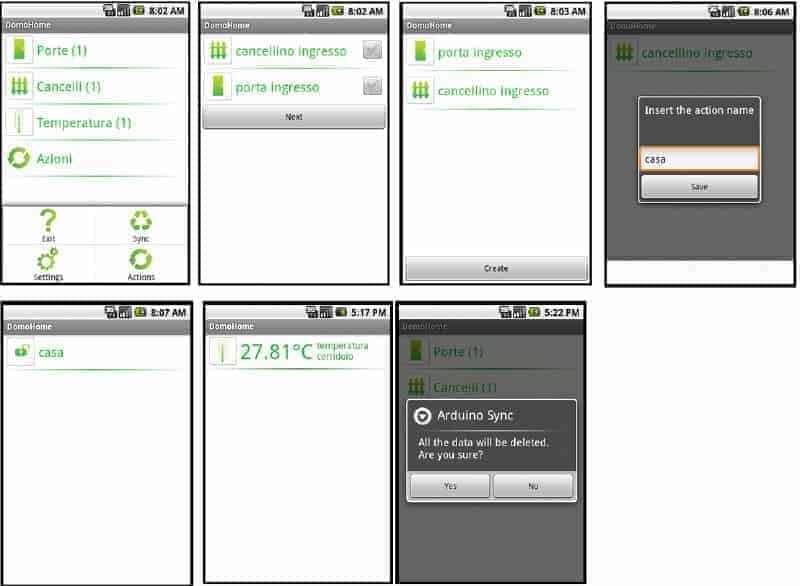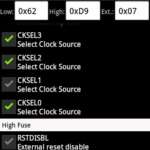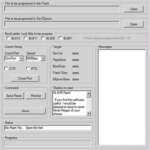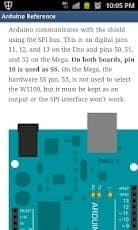Smartphone devices are as valuable as there are some useful apps there. So I started wondering if there are electronics/microcontroller-related apps that could be useful in daily work. Let’s see what we can find in an in-app store.

First of all, we are interested in free apps. Search on AVR microcontrollers gave me coupe results: AVR Fuse Calculator and Using Atmega128 apps. Let’s see what they are capable of.
AVR Fuse calculator
This is a free, lightweight app for Android phones developed by Michael Schwarz. If you have used a web-based fuse calculator, this app practically has the same functionality. It has a list of 144 supported AVR devices. The touch screen makes it easy to select instruments and mark fuses by selecting check-boxes with full fuse names. Instantly high and low fuse bytes are updated on the top of the screen. After you have selected a fuse, you can quickly generate an AVRDude command line used during MCU flashing.
This is number one app for daily use with AVR microcontrollers.
Using Atmega128
Another app I could find is Using Atmega128 (AVR128). This application is nothing more than a reference to Atmage128 specifications. It has some organized info on this microcontroller like specs, link to datasheet, some standard circuits like clocking, reset, ISP, serial. There is a section about setting fuses using PonyProg and using the bootloader.
This app is only referencing, so it can be used for a quick refresher. But it is tied to a single microcontroller, so that it might be useful for a tiny group of people.
AVR128 Assembly summary
This is another reference app developed by Black Lake. It is an Atmega128 assembly language reference. When you open it, you can scroll through all ASM instructions. Select any instruction to view its extended information, including operand, its operation, flags affected, and required clock cycles. Great reference if you are programming AVR using ASM language. But probably, you will be using a PC-based document when writing a program. Also, I find it very hard to read grey fonts on a black background.
What about Arduino?
Speaking of Arduino, there is a better situation. There are two many of them, so that I would mention a few of them. The first app compatible with Samsung Galaxy Ace is called Arduino Reference, developed by Rod Lalonde. It practically holds reference information you can find on the Arduino project page. This is great for online use. Sadly it doesn’t keep track of changes. The last supported Arduino IDE is 0019.
Domotic Home with Arduino application is a nice attempt to automate home appliances using android device wifi functionality. All you need is Arduino with a WiFi shield and relay board.

If you are looking to synchronize mobile with Arduino this is worth trying.
Another interesting app that can be used with any microcontroller is Audio Serial Out. I haven’t tested it, but it looks promising. It allows controlling devices using an audio output jack for serial data transfer. It lacks real-time control but could control robots, cameras, and other gadgets with cheap implementation.
After this follows a bunch of Bluetooth communication apps that can be used for sending data to Arduino Bluetooth shield, as I have no means to test them right now, I will leave this topic open.
PICmicro Database
The last app I’m gonna mention is the PICmicro database. This application allows easy searching through microcontroller list, filter by several criteria like program memory, RAM, and family. Can display specifications on selected micro, as you would see in the datasheet.
There are several more apps, but mostly references or demo versions of paid. It seems that there is still a way to go in this segment as smart mobile phones are spreading like a virus.











Hi Scienceprog,
In addition to your post I was wondering, I need a recommendation for what language I should use to do serial communications over RS232. I know a little C++ but all I learned was console apps. I have tried VB because there is a “com control” already in it, but I didn’t get very far with it.
I need something that I can set up my own protocol as well as the standard com stuff (baud, Xon/Xoff, etc.) It will be communicating with a microcontroller. Right now is communicating via “Hyper terminal”, but I want something…. prettier. I well be starting another C class in a couple of weeks, but I think its going to be another “Intro to…”
Cheers